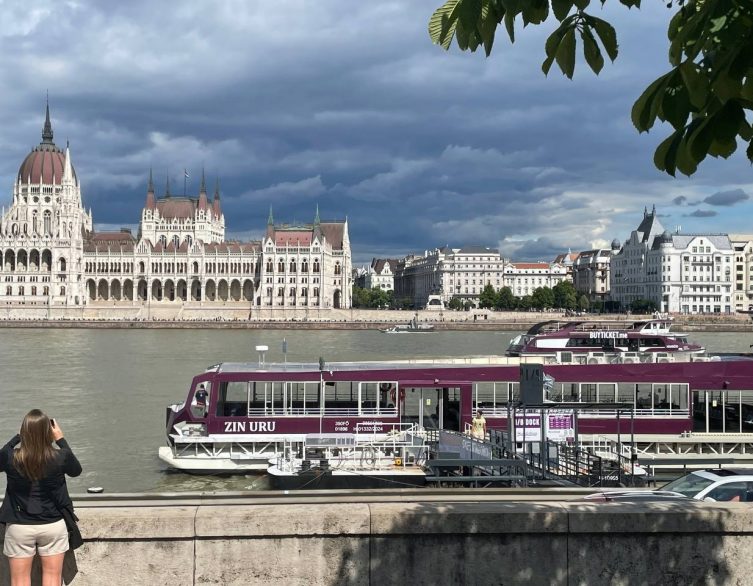How To Get To Budapest – arriving by Train

Budapest, the stunning capital of Hungary, is a popular destination for travelers across Europe. With its extensive rail connections, reaching Budapest by train is not only convenient but also offers a scenic journey through the heart of Europe. Here’s what you need to know to plan your train trip to Budapest.
International Rail Lines To Budapest
Traveling to Budapest by train using international rail lines is a convenient and enjoyable way to reach the Hungarian capital. Budapest is well-connected to various European cities through an extensive rail network, making it an ideal destination for those who prefer to travel by train.
When booking your Budapest railway tickets, consider factors such as travel time, the number of transfers required, and your preferred class of service. International trains often offer a range of options, from budget-friendly seats to more luxurious sleeping compartments. Sleeper trains can be an excellent choice for longer journeys, allowing you to save on accommodation costs and wake up refreshed in Budapest.
To begin your journey, you’ll need to determine your starting point and book your tickets in advance. Budapest is serviced by several international rail lines, including the EuroCity, InterCity, and RailJet trains. These trains connect Budapest to cities such as Vienna, Prague, Berlin, and Munich, among others. Booking your tickets early can help you secure a seat and potentially save money on fares.
Once you’ve boarded your train, sit back and relax as you watch the picturesque landscapes of Central Europe pass by your window. Depending on your route, you may travel through the rolling hills of the Czech Republic, the charming villages of Austria, or the lush forests of Slovakia before arriving in Hungary.
As you embark on your train journey, take the time to enjoy the scenic landscapes that pass by your window. The route to Budapest often takes you through picturesque countrysides, charming villages, and historic towns. Many trains also offer dining options, ranging from simple snacks to full-service restaurant cars, ensuring you can enjoy a meal or a drink during your trip.
As you approach Budapest, you’ll catch glimpses of the mighty Danube River, which divides the city into two distinct regions: Buda and Pest. The train will arrive at one of Budapest’s main railway stations, such as Keleti, Nyugati, or Déli station. These stations are well-connected to the city’s public transportation network, making it easy to reach your final destination within Budapest. Taxis and ride-sharing services are also readily available at the stations.
Upon arrival, take a moment to admire the grandeur of the railway stations themselves. Keleti station, for example, is a magnificent example of neo-Renaissance architecture, with its ornate façade and soaring glass atrium. Nyugati station, designed by the renowned Eiffel Company, features a stunning iron and glass structure reminiscent of a grand pavilion.
It’s important to note that train schedules and routes may vary depending on the time of year and any ongoing maintenance or renovations. Be sure to check the latest information with the relevant railway companies or travel agencies to ensure a smooth and uninterrupted journey.
Traveling to Budapest by train not only offers a convenient and comfortable way to reach this enchanting city but also provides an opportunity to immerse yourself in the beauty and culture of Central Europe along the way. As you embark on your rail adventure, you’ll create unforgettable memories and gain a deeper appreciation for the diverse landscapes and rich history that characterize this captivating region.
Train From Vienna To Budapest
Traveling by train from Vienna to Budapest is not just a means of transportation; it’s an experience that offers a glimpse into the heart of Central Europe. This popular route connects two of the region’s most beautiful capital cities, taking passengers on a journey through picturesque landscapes and rich history.
The Journey: The train ride from Vienna to Budapest typically takes about 2.5 to 3 hours, covering a distance of approximately 250 kilometers (155 miles). The route is serviced by several train operators, including ÖBB (Austrian Federal Railways) and MÁV (Hungarian State Railways), with multiple departures daily.
Departure: Your journey begins at Vienna’s impressive Hauptbahnhof (Main Station), a modern transportation hub in the heart of the Austrian capital. It’s advisable to arrive at least 30 minutes before departure to navigate the station and find your platform comfortably.
The Ride: As you leave Vienna, the train passes through the eastern Austrian countryside, offering views of rolling hills, quaint villages, and farmlands. The route then crosses into Hungary, where the landscape gradually transforms into the Small Hungarian Plain, known for its vast, open spaces.
Arrival: The train terminates at either Budapest Keleti or Nyugati station, travelers will find themselves in the heart of the Hungarian capital, ready to explore its stunning architecture, thermal baths, and vibrant culture.
Ticket Options: Travelers can choose between standard and first-class tickets. First-class offers more spacious seating and often includes complimentary refreshments. It’s recommended to book tickets in advance, especially during peak travel seasons, to secure the best prices and ensure availability.
On-board Amenities: Most trains on this route offer comfortable seating, ample luggage space, and power outlets. Some services also provide Wi-Fi, though connectivity can be intermittent during the journey.
Border Crossing: While both Austria and Hungary are part of the Schengen Area, occasional passport checks may occur. It’s always wise to have your travel documents easily accessible.
The train from Vienna to Budapest offers a comfortable, efficient, and scenic way to travel between these two iconic cities. It’s an opportunity to sit back, relax, and watch Central Europe unfold before your eyes, making the journey as memorable as the destinations themselves.
Prague to Budapest
For travelers looking to experience the heart of Central Europe, the train journey from Prague to Budapest offers a picturesque and comfortable way to connect these two iconic cities. This route not only provides a convenient means of transportation but also allows passengers to enjoy stunning landscapes and charming towns along the way.
The Journey: The direct train from Prague to Budapest typically takes around 6.5 to 7 hours, covering a distance of approximately 530 kilometers (330 miles). The most popular service on this route is operated by České dráhy (Czech Railways) in cooperation with Hungarian State Railways (MÁV), running several times daily.
Departure and Arrival: Trains depart from Prague’s main station, Praha hlavní nádraží, and arrive at Budapest Keleti station. Both stations are centrally located and well-connected to public transportation networks in their respective cities.
Ticket Options: Travelers can choose between different classes of service, including standard seats and more comfortable first-class compartments. It’s advisable to book tickets in advance, especially during peak travel seasons, to secure the best prices and ensure availability.
Scenic Route: The journey takes passengers through the beautiful countryside of the Czech Republic, Slovakia, and Hungary. Highlights include views of the Bohemian and Moravian landscapes, the Little Carpathian mountains, and the Danube River as you approach Budapest.
On-board Amenities: Most trains on this route offer comfortable seating, power outlets, and Wi-Fi access. Some services also include a dining car or trolley service for refreshments during the journey.
Border Crossing: While both the Czech Republic and Hungary are part of the Schengen Area, there may be passport checks during the journey, so it’s important to keep your travel documents easily accessible.
Stopover Options: For those looking to break up the journey, consider a stopover in Bratislava, the capital of Slovakia. Many trains on this route make a stop here, allowing travelers to explore another charming Central European city.
Arrival in Budapest: Upon arrival at either Budapest Keleti or Nyugati station, travelers will find themselves in the heart of the Hungarian capital, ready to explore its stunning architecture, thermal baths, and vibrant culture.
Traveling by train from Prague to Budapest offers a relaxed and scenic way to experience Central Europe. It combines the convenience of city-center departures and arrivals with the romance of rail travel, making it an excellent choice for those looking to immerse themselves in the region’s beauty and history.
Munich to Budapest
For travelers seeking a scenic and comfortable way to explore Central Europe, the train journey from Munich, Germany to Budapest, Hungary offers a delightful experience. This route not only connects two of Europe’s most vibrant cities but also provides passengers with stunning views of the countryside along the way.
The Journey: The direct train from Munich to Budapest typically takes about 7 to 8 hours, covering a distance of approximately 680 kilometers (422 miles). The route is serviced by comfortable EuroCity trains, operated jointly by Deutsche Bahn and Hungarian Railways (MÁV).
Departure and Arrival: Trains depart from Munich Hauptbahnhof (Central Station) and arrive at Budapest Keleti station. There are usually two to three direct services per day, with additional options involving a connection in Vienna.
Scenic Route: As you leave Munich, the train travels through the picturesque Bavarian countryside before entering Austria. You’ll pass through Salzburg, known for its baroque architecture and as the birthplace of Mozart. The journey continues through the beautiful Austrian landscape, offering views of the Alps in the distance.
Border Crossing: While both Germany, Austria and Hungary are part of the Schengen Area, there may be passport checks during the journey, so it’s important to keep your travel documents easily accessible. After crossing into Hungary, the train passes through the western part of the country, showcasing the Hungarian plains and rural landscapes before arriving in the heart of Budapest.
Onboard Experience: EuroCity trains offer comfortable seating in both first and second-class carriages. Many trains include a dining car or at least a snack trolley service. Wi-Fi is often available, allowing passengers to stay connected during the journey.
Arrival in Budapest: Upon arrival at Budapest Keleti, you’ll find yourself conveniently located near the city center. From either station, you can easily access Budapest’s excellent public transportation system to reach your final destination in the city.
This train journey not only offers a comfortable and eco-friendly way to travel between Munich and Budapest but also provides an opportunity to witness the changing landscapes of three countries. It’s an excellent choice for those who wish to immerse themselves in the journey as much as the destination.
Berlin to Budapest
Embarking on a train journey from Berlin to Budapest is a fantastic way to experience the heart of Europe, combining comfort, scenery, and the charm of cross-border travel. This route, spanning approximately 850 kilometers (528 miles), takes you through three countries and offers a glimpse into the changing landscapes and cultures of Central Europe.
The Journey: The Berlin to Budapest train route typically takes around 11 to 12 hours, depending on the specific train and connections. Most journeys involve a transfer, usually in Vienna or Prague, adding to the adventure and allowing you to briefly explore another major European city.
Trains and Tickets: Several train companies operate on this route, including Deutsche Bahn (DB) and ÖBB (Austrian Federal Railways). The most common options are:
- Day trains: These offer regular seats and, on some services, first-class compartments.
- Night trains: ÖBB’s Nightjet service provides a range of accommodations, from seated coaches to sleeper cabins.
It’s advisable to book tickets in advance, especially during peak travel seasons. Prices can vary significantly based on how far in advance you book and the type of ticket (flexible or fixed date).
Scenic Highlights: The journey takes you through diverse landscapes from the rolling hills and lush forests in Germany, through the Austrian Alps if traveling via Vienna, or the picturesque towns and the Elbe River valley in the Czech Republic all the way to the Hungarian small plains with expanses of farmland as you approach Budapest.
Border Crossings: While part of the Schengen Area, you may still experience passport checks at borders. These are usually quick and conducted on the train.
Onboard Experience: EuroCity trains offer comfortable seating in both first and second-class carriages. Many trains include a dining car or at least a snack trolley service. Wi-Fi is often available, allowing passengers to stay connected during the journey.
Arrival in Budapest: Upon arrival at either Budapest Keleti or Nyugati station, you’ll find yourself conveniently located near the city center. From either station, you can easily access Budapest’s excellent public transportation system to reach your final destination in the city.
Best deals of Budapest
Traveling from Berlin to Budapest by train is not just about reaching your destination; it’s about embracing the journey itself. This route offers a unique perspective on Central Europe, allowing you to sit back, relax, and watch the continent unfold before your eyes. Whether you choose a day train to soak in the scenery or a night train to maximize your time, this rail adventure promises to be a memorable part of your European experience.
Zagreb to Budapest
For travelers seeking a comfortable and picturesque way to journey between two of Central Europe’s most captivating capitals, the train route from Zagreb, Croatia to Budapest, Hungary offers an excellent option. This railway adventure not only connects you to two vibrant cities but also treats you to stunning landscapes along the way.
The Journey: The train ride from Zagreb to Budapest typically takes about 6 to 7 hours, covering a distance of approximately 365 kilometers (227 miles). The route is operated by Croatian Railways (HŽ) and Hungarian State Railways (MÁV), with usually one or two direct trains running daily.
Departure and Arrival: Your journey begins at Zagreb Glavni kolodvor, the main railway station in Croatia’s capital. The train terminates at Budapest Keleti pályaudvar, one of the main international railway terminals in Hungary’s capital.
Scenic Views: As you leave Zagreb, the train winds its way through the picturesque Croatian countryside, offering views of rolling hills, quaint villages, and lush forests. Crossing into Hungary, you’ll witness the Great Hungarian Plain, known for its vast expanses and traditional farms.
Border Crossing: The train crosses the Croatia-Hungary border at Gyékényes. While both countries are in the European Union, passport checks may still occur, so keep your travel documents handy.
Onboard Amenities: Most trains on this route offer comfortable seating, air conditioning, and power outlets. Some trains may also have a dining car or trolley service for refreshments.
Arrival in Budapest: Upon arrival at Budapest Déli station, you’ll find yourself conveniently located near the city center, with easy access to public transportation to reach your final destination in the Hungarian capital.
This train journey not only provides an efficient means of travel between Zagreb and Budapest but also offers a chance to relax and enjoy the changing landscapes of Croatia and Hungary. It’s a journey that combines practicality with the romance of rail travel, making it an attractive option for those looking to explore Central Europe at a leisurely pace.
Purchasing Tickets To Budapest
Traveling to Budapest by train can be a delightful and convenient way to explore the beautiful Hungarian capital. If you’re planning a trip to Budapest and prefer to travel by rail, here’s a detailed guide on how to secure your train tickets.
Traveling Within Hungary
If you’re traveling from within Hungary or if you’re coming from another European country you can easily book your tickets through the Hungarian State Railways (MÁV) website or at any MÁV ticket office. However, if you’re coming from another European country, you’ll need to research the available international train routes and book your tickets accordingly.
In case you are already in Budapest, train tickets can be easily purchased by using the MÁV application or visiting one of the ticket offices at the train stations.
Traveling Internationally
For international train travel, you can use the websites of the respective national rail companies of your country of origin or the Hungarian State Railways (MÁV) website. You can also use European rail booking platforms which offer a user-friendly interface that allows you to search for available trains, compare prices, and book your tickets easily.
International booking platforms to book your train tickets in Europe:
When booking your tickets, consider factors such as travel dates, train schedules, and ticket types. If you have a flexible itinerary, look for off-peak travel times or slower train services, as they often come with lower fares. Additionally, decide whether you prefer a seat reservation or are comfortable with an open seating arrangement.
Depending on your departure point, you may encounter different types of trains:
- EuroCity (EC) trains: Fast, comfortable trains connecting major European cities
- InterCity (IC) trains: Domestic Hungarian trains and some international routes
- Regional trains: For shorter distances within countries
It’s advisable to book your tickets well in advance, especially during peak travel seasons or holidays, to secure your desired seats and avoid any last-minute hassles. Some train services may offer discounted fares for early bookings, so keep an eye out for such deals.
If you’re traveling on a budget, consider purchasing second-class tickets instead of first-class ones. While first-class carriages offer more spacious seats and additional amenities, second-class seats are generally comfortable enough for most travelers and can help you save money.
Once you’ve successfully booked your tickets, make sure to carefully review the booking confirmation and take note of any important information such as the train number, departure time, and seat reservations. It’s also a good idea to familiarize yourself with the luggage policies of the train service you’ll be using to ensure a smooth journey.
On the day of your travel, arrive at the train station with ample time to locate your platform and board your train. Have your tickets and identification documents readily available, as they may be checked by the train staff during your journey.
As you sit back and relax on your train ride to Budapest, take in the picturesque landscapes and enjoy the convenience of rail travel. With a little planning and preparation, securing your train tickets to Budapest can be a breeze, allowing you to focus on the exciting adventures that await you in this enchanting city.
Budapest Train Arrivals
Keleti Railway Station (Eastern Railway Station)
When traveling to Budapest by rail, chances are you’ll arrive at the city’s largest and busiest railway hub, Keleti Railway Station (Budapest Keleti pályaudvar). This historic station, whose name translates to “Eastern Railway Station,” serves as a gateway for both domestic and international travelers.
Built in 1884, Keleti Railway Station is an architectural marvel that combines functionality with stunning 19th-century design. As you step off your train, you’ll be greeted by the station’s impressive facade, adorned with statues and a large clock tower that has become an iconic symbol of Budapest’s railway heritage.
Location and Accessibility
Keleti Station is conveniently located in Budapest’s 8th district, about 3 kilometers east of the city center. Its central position makes it easy to access various parts of the city upon arrival. The station is well-connected to Budapest’s public transportation network, with metro lines 2 and 4 stopping directly at the station, as well as numerous bus and tram lines nearby.
Station Facilities
Inside the station, you’ll find a range of amenities to cater to travelers’ needs. These include:
- Information desks
- Ticket offices for domestic and international travel
- Currency exchange booths
- ATMs
- Left luggage facilities
- Food and beverage outlets
- Small shops for essentials and souvenirs
Navigating the Station
At the Budapest Keleti arrival, simply follow the signs to get you through the station. The layout is relatively straightforward, the main hall houses the ticket offices and information points, while platforms are easily accessible via stairs or elevators.
Onward Travel
From Keleti, you have several options to reach your final destination in Budapest:
- Metro: The most convenient option for many travelers, with direct connections to the city center.
- Taxi: There’s a designated taxi stand outside the main entrance.
- Bus or Tram: Various lines stop near the station, offering connections to different parts of the city.
- Walking: If you’re staying nearby, walking might be a pleasant option to start exploring the city.
Tips for Travelers
- Be cautious of unofficial taxi drivers or people offering unsolicited help with luggage.
- If you need to exchange money, it’s often better to use ATMs or official exchange offices rather than individual money changers.
- Consider purchasing a Budapest Card at the tourist information point for discounted public transport and entry to various attractions.
- Validate your metro ticket before entering the platform area
- Be aware of your surroundings and keep an eye on your belongings, as with any busy transit hub
- Validate your metro ticket before entering the platform area
Arriving at Keleti Railway Station offers a quintessential Budapest experience, combining historical charm with modern convenience. As you exit the station, you’ll find yourself perfectly positioned to begin your Hungarian adventure in one of Europe’s most captivating capitals.
Nyugati Railway Station (Western Railway Station)
When traveling to Budapest by rail, many visitors find themselves arriving at the historic Nyugati Railway Station, also known as the Western Railway Station. This iconic transportation hub, located in the heart of the city, offers a grand welcome to Hungary’s vibrant capital.
Built in 1877 and designed by the Eiffel Company (of Eiffel Tower fame), Nyugati Railway Station is a stunning example of 19th-century architecture. Its impressive wrought-iron structure and large clock tower make it an attraction in its own right, giving travelers a taste of Budapest’s rich history from the moment they step off the train.
Location and Accessibility
Nyugati Railway Station is conveniently situated in Budapest’s 6th district, making it an ideal starting point for exploring the city. The station is well-connected to Budapest’s excellent public transportation system, with access to:
- Metro: The M3 (blue) line stops directly at the station.
- Trams: Lines 4 and 6 run in front of the station.
- Buses: Several local and night bus routes serve the area.
Facilities and Services
The station offers a range of amenities to ensure a smooth arrival:
- Information desk for travel inquiries
- Ticket offices for domestic and international train travel
- Currency exchange booths
- ATMs
- Left luggage facilities
- Shops and cafes for quick refreshments
Upon Arrival
After the Budapest Nyugati arrival, follow the signs to the main hall. Here, you’ll find the ticket offices and information desk if you need assistance. For those continuing their journey by public transport, follow signs to the metro station or tram stops.
Tips for Travelers
- Be cautious of unofficial taxi drivers or people offering unsolicited help with luggage.
- If you need to exchange money, it’s often better to use ATMs or official exchange offices rather than individual money changers.
- Consider purchasing a Budapest Card at the tourist information point for discounted public transport and entry to various attractions.
- Validate your metro ticket before entering the platform area
- Be aware of your surroundings and keep an eye on your belongings, as with any busy transit hub
- Validate your metro ticket before entering the platform area
Nearby Attractions
The area surrounding Nyugati Railway Station is worth exploring. Within walking distance, you’ll find:
- WestEnd City Center: A large shopping mall adjacent to the station
- Margaret Island: A beautiful park island in the Danube, accessible via tram
- Hungarian Parliament Building: About a 20-minute walk or a short metro ride away
Whether you’re visiting Budapest for business or pleasure, arriving at Nyugati Railway Station offers a convenient and historically rich entry point to this beautiful city. From here, the wonders of Budapest are at your fingertips, ready to be explored.
Déli Railway Station (Southern Railway Station)
When traveling to Budapest by rail, one of the main entry points to the city is the Déli Railway Station, also known as the Southern Railway Station. Located in the Buda side of the city, this historic station offers travelers a convenient gateway to Hungary’s captivating capital.
Déli Railway Station, or “Déli pályaudvar” in Hungarian, was built in 1861 and has been serving passengers for over 150 years. The station’s architecture reflects a blend of classical and modern styles, with its most recent renovation completed in the 1970s. While not as grandiose as some of Europe’s other railway terminals, it maintains a functional charm that speaks to its long history.
Location and Accessibility
Situated at the foot of Buda Hills, Déli Railway Station is well-connected to the city’s public transportation network. The station has its own metro stop on the M2 (red) line, making it easy for arriving passengers to reach other parts of Budapest. Several bus and tram lines also serve the station, providing additional transit options.
Facilities and Services
Despite its age, Déli Railway Station offers modern amenities to cater to travelers’ needs. Inside, you’ll find:
- Ticket offices and automated ticket machines
- Information desks
- Currency exchange services
- Small shops and cafes
- Luggage storage facilities
- Public restrooms
Upon Arrival
Upon arrival, passengers will disembark onto one of the station’s platforms. The main concourse is easily accessible, where you can find transportation information, maps, and other services. For those needing assistance, station staff are generally available to help with directions or other queries.
Onward Travel
From Déli Railway Station, Budapest’s city center is easily reachable. The Buda Castle district is relatively close, while a short metro ride can take you to the Pest side of the city. Taxis are also available outside the station for those preferring direct transportation to their destination.
Tips for Travelers
- Be cautious of unofficial taxi drivers or people offering unsolicited help with luggage.
- If you need to exchange money, it’s often better to use ATMs or official exchange offices rather than individual money changers.
- Consider purchasing a Budapest Card at the tourist information point for discounted public transport and entry to various attractions.
- Validate your metro ticket before entering the platform area
- Be aware of your surroundings and keep an eye on your belongings, as with any busy transit hub
- Validate your metro ticket before entering the platform area
Arriving at Déli Railway Station offers travelers a smooth introduction to Budapest. Its central location and good connections make it an excellent starting point for exploring this beautiful city on the Danube.
Traveling to Budapest by Train: Essential Tips for a Smooth Journey
Budapest is a popular destination for travelers from all over Europe. Opting to travel by train can be a comfortable, scenic, and eco-friendly way to reach this beautiful city. Here are some essential tips to make your train journey to Budapest as smooth and enjoyable as possible.
- Plan Your Route: There are several routes to Budapest from major European cities. Popular connections include Vienna-Budapest, Prague-Budapest, and Munich-Budapest. Research the best route from your starting point and consider factors like travel time, number of transfers, and scenic value. Be aware of time zone changes as you cross borders.
- Book in Advance: To secure the best prices and ensure seat availability, book your tickets well in advance. Many railway companies offer early bird discounts, so planning ahead can save you money.
- Choose the Right Type of Train: Different types of trains operate on these routes, including high-speed trains, overnight sleeper trains, and regional trains. High-speed options like the RailJet are faster but may be more expensive. Overnight trains can save you on accommodation costs but may be less comfortable for light sleepers.
- Consider a Rail Pass: If you’re planning to visit multiple countries, a Eurail Pass might be more cost-effective than buying individual tickets. Check if your itinerary would benefit from this option.
- Pack Light: Train travel is more comfortable when you’re not lugging around heavy bags. Pack efficiently and remember that you’ll need to store your luggage either overhead or in designated areas.
- Bring Entertainment and Snacks: While many trains offer dining cars, it’s always a good idea to bring some snacks and water. Don’t forget books, podcasts, or other forms of entertainment for the journey.
- Be Prepared for Border Crossings: If you’re traveling from outside the Schengen Area, be ready to show your passport and any necessary visas during border checks. Ensure your passport is valid for at least six months beyond your planned stay. Check if you need a visa to enter Hungary.
- Arrive Early at the Station: Give yourself plenty of time to find your platform and board the train. European train stations can be large and busy, so arriving early reduces stress.
- Learn Basic Hungarian Phrases: While many Hungarians in the tourism industry speak English, learning a few basic phrases in Hungarian can be helpful and appreciated.
- Plan Your Arrival: Research how to get from Budapest’s main train station (usually Budapest-Keleti) to your accommodation. Public transportation in Budapest is excellent, but it’s good to know your options in advance.
- Enjoy the Scenery: One of the best parts of train travel is the opportunity to see the changing landscape. The approach to Budapest, especially along the Danube, can be particularly beautiful.
By following these tips, you’ll be well-prepared for a fantastic train journey to Budapest. This mode of travel not only gets you to your destination but also allows you to enjoy the journey itself, making it an integral part of your European adventure.
Advantages of Traveling by Train to Budapest
When planning a trip to the captivating city of Budapest, consider embarking on a scenic and comfortable journey by train. Opting for rail travel to reach the Hungarian capital offers numerous advantages that can enhance your overall travel experience. Here are some compelling reasons to choose the train for your Budapest adventure:
- Scenic Routes and Breathtaking Views: Train travel to Budapest allows you to witness the stunning landscapes of Central Europe. As you glide through picturesque countryside, rolling hills, and charming villages, you’ll have the opportunity to appreciate the region’s natural beauty and cultural diversity.
- Comfort and Relaxation: Unlike the cramped quarters of airplanes or the constant stops of bus travel, trains offer spacious seating, the freedom to move around, and a smooth ride. You can relax, read a book, or simply gaze out the window while the scenery unfolds before you.
- City Center Arrivals: Most train stations in Budapest are centrally located, allowing you to arrive right in the heart of the city. This convenience saves time and money on additional transportation from airports or bus terminals on the outskirts of town.
- Environmental Friendliness: Choosing train travel significantly reduces your carbon footprint compared to flying or driving. It’s an eco-conscious choice that aligns with sustainable tourism practices.
- No Airport Hassles: Say goodbye to long security lines, baggage restrictions, and the stress of arriving hours before departure. Train travel offers a more relaxed pre-journey experience with simpler check-in procedures.
- Flexible Scheduling: Trains to Budapest often run frequently, providing more scheduling options than flights. This flexibility allows you to plan your trip according to your preferences and itinerary.
- Cost-Effective Option: Depending on your departure point, train travel can be more economical than flying, especially when factoring in baggage fees and transportation to and from airports.
- Cultural Immersion: Train journeys offer unique opportunities to interact with locals and fellow travelers, providing insights into the region’s culture before you even reach your destination.
- Generous Baggage Allowances: Unlike airlines, trains typically have more lenient baggage policies, allowing you to bring more items without incurring extra fees.
- Seamless Multi-City Trips: If you’re planning to visit multiple European destinations, train travel makes it easy to hop from one city to another, creating a more comprehensive and enjoyable tour of the region.
Conclusion
Choosing to travel to Budapest by train not only gets you to your destination but also transforms your journey into an integral part of your travel experience. From stunning views and comfortable accommodations to environmental benefits and cultural immersion, train travel offers a unique and rewarding way to begin your Budapest adventure. So sit back, relax, and let the train whisk you away to the enchanting capital of Hungary.

















